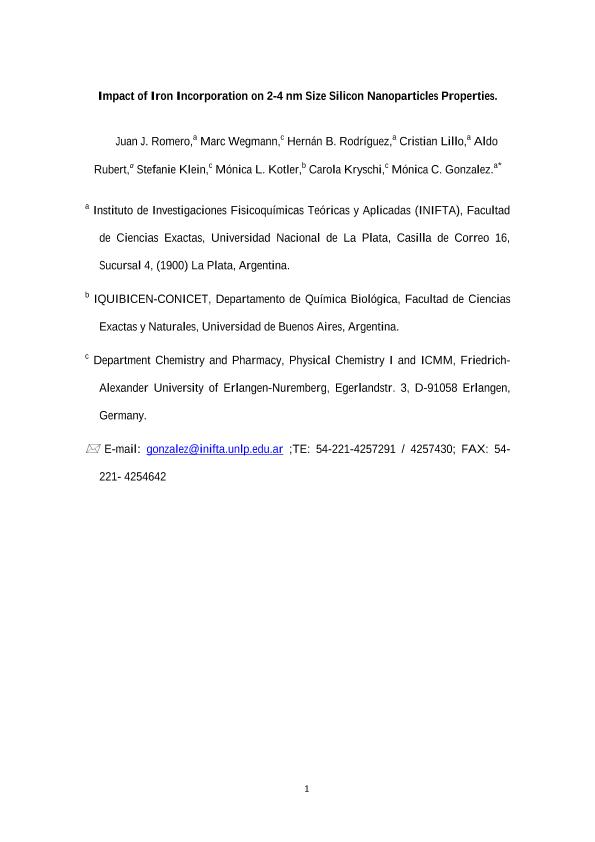Mostrar el registro sencillo del ítem
dc.contributor.author
Romero, Juan José
dc.contributor.author
Wegmann, Marc
dc.contributor.author
Rodriguez, Hernan Bernardo

dc.contributor.author
Lillo, Rolando Cristian Rodrigo

dc.contributor.author
Rubert, Aldo Alberto

dc.contributor.author
Klein, Stefanie
dc.contributor.author
Kotler, Monica Lidia

dc.contributor.author
Kryschi, Carola
dc.contributor.author
Gonzalez, Monica Cristina

dc.date.available
2016-05-03T14:53:09Z
dc.date.issued
2015-03
dc.identifier.citation
Romero, Juan José; Wegmann, Marc; Rodriguez, Hernan Bernardo; Lillo, Rolando Cristian Rodrigo; Rubert, Aldo Alberto; et al.; Impact of Iron Incorporation on 2-4 nm Size Silicon Nanoparticles Properties; American Chemical Society; Journal of Physical Chemistry C; 119; 10; 3-2015; 5739-5746
dc.identifier.issn
1932-7455
dc.identifier.uri
http://hdl.handle.net/11336/5465
dc.description.abstract
Iron-containing silicon nanoparticles were synthesized in an attempt to understand the effect of iron on the silicon nanoparticle (SiNP) photoluminescence and singlet-oxygen generation capacity. A wet chemical oxidation procedure of the sodium silicide precursor, obtained from the thermal treatment of a mixture of sodium, silicon, and an iron(III) organic salt under anaerobic conditions, was employed. Surface-oxidized and propylamine-terminated SiNPs were characterized using high-resolution transmission electron microscopy, X-ray photoelectron spectroscopy, time-resolved and steady-state photoluminescence, and time-correlated fluorescence anisotropy. On the basis of differences in the morphology, crystal structure, density, and photoluminescence spectrum, two distinct types of SiNPs were identified in a given synthesis batch: iron-free and iron-containing SiNPs. The results show that iron is inhomogeneously incorporated in the SiNPs leading to an efficient photoluminescence quenching. Emission arrives mainly from 2 nm size iron-free SiNPs. The nanoparticles were shown to generate singlet oxygen (1O2) upon 355 nm irradiation, though they were able to quench 1O2. Analysis of cytotoxicity using MTT assay on rat glioma C6 cells showed a strong dependence on the nature of the surface groups, as 100 μg/mL of propylamine-terminated iron-containing SiNPs leads to 85% decrease in cell viability while equal amounts of surface oxidized particles induced a 35% of cell death.
dc.format
application/pdf
dc.language.iso
eng
dc.publisher
American Chemical Society

dc.rights
info:eu-repo/semantics/openAccess
dc.rights.uri
https://creativecommons.org/licenses/by-nc-sa/2.5/ar/
dc.subject
Iron
dc.subject
Quenching
dc.subject
Optical
dc.subject
Properties
dc.subject
Surface
dc.subject
Chemistry
dc.subject.classification
Nano-materiales

dc.subject.classification
Nanotecnología

dc.subject.classification
INGENIERÍAS Y TECNOLOGÍAS

dc.title
Impact of Iron Incorporation on 2-4 nm Size Silicon Nanoparticles Properties
dc.type
info:eu-repo/semantics/article
dc.type
info:ar-repo/semantics/artículo
dc.type
info:eu-repo/semantics/publishedVersion
dc.date.updated
2016-05-06 15:52:43.262787-03
dc.journal.volume
119
dc.journal.number
10
dc.journal.pagination
5739-5746
dc.journal.pais
Estados Unidos

dc.journal.ciudad
Washington
dc.conicet.avisoEditorial
This document is the Accepted Manuscript version of a Published Work that appeared in final form in The Journal of Physical Chemistry C, copyright © American Chemical Society after peer review and technical editing by the publisher. To access the final edited and published work see [insert ACS Articles on Request author-directed link to Published Work, see http://pubs.acs.org/page/policy/articlesonrequest/index.html].
dc.description.fil
Fil: Romero, Juan José. Consejo Nacional de Investigaciones Científicas y Técnicas. Centro Científico Tecnológico la Plata. Instituto de Investigaciones Fisicoquímicas Teóricas y Aplicadas; Argentina. Universidad Nacional de La Plata; Argentina
dc.description.fil
Fil: Wegmann, Marc. Friederich-Alexander University of Erlangen-Nuremberg; Alemania
dc.description.fil
Fil: Rodriguez, Hernan Bernardo. Consejo Nacional de Investigaciones Científicas y Técnicas. Centro Científico Tecnológico la Plata. Instituto de Investigaciones Fisicoquímicas Teóricas y Aplicadas; Argentina. Universidad Nacional de La Plata; Argentina
dc.description.fil
Fil: Lillo, Rolando Cristian Rodrigo. Consejo Nacional de Investigaciones Científicas y Técnicas. Centro Científico Tecnológico la Plata. Instituto de Investigaciones Fisicoquímicas Teóricas y Aplicadas; Argentina. Universidad Nacional de La Plata; Argentina
dc.description.fil
Fil: Rubert, Aldo Alberto. Consejo Nacional de Investigaciones Científicas y Técnicas. Centro Científico Tecnológico la Plata. Instituto de Investigaciones Fisicoquímicas Teóricas y Aplicadas; Argentina. Universidad Nacional de La Plata; Argentina
dc.description.fil
Fil: Klein, Stefanie. Friederich-Alexander University of Erlangen-Nuremberg; Alemania
dc.description.fil
Fil: Kotler, Monica Lidia. Consejo Nacional de Investigaciones Científicas y Técnicas. Oficina de Coordinación Administrativa Ciudad Universitaria. Instituto de Química Biológica de la Facultad de Ciencias Exactas y Naturales; Argentina
dc.description.fil
Fil: Kryschi, Carola. Friederich-Alexander University of Erlangen-Nuremberg; Alemania
dc.description.fil
Fil: Gonzalez, Monica Cristina. Consejo Nacional de Investigaciones Científicas y Técnicas. Centro Científico Tecnológico la Plata. Instituto de Investigaciones Fisicoquímicas Teóricas y Aplicadas; Argentina. Universidad Nacional de La Plata; Argentina
dc.journal.title
Journal of Physical Chemistry C

dc.relation.alternativeid
info:eu-repo/semantics/altIdentifier/url/http://pubs.acs.org/doi/pdf/10.1021/acs.jpcc.5b00172
dc.relation.alternativeid
info:eu-repo/semantics/altIdentifier/doi/http://dx.doi.org/10.1021/acs.jpcc.5b00172
dc.relation.alternativeid
info:eu-repo/semantics/altIdentifier/doi/10.1021/acs.jpcc.5b00172
Archivos asociados
